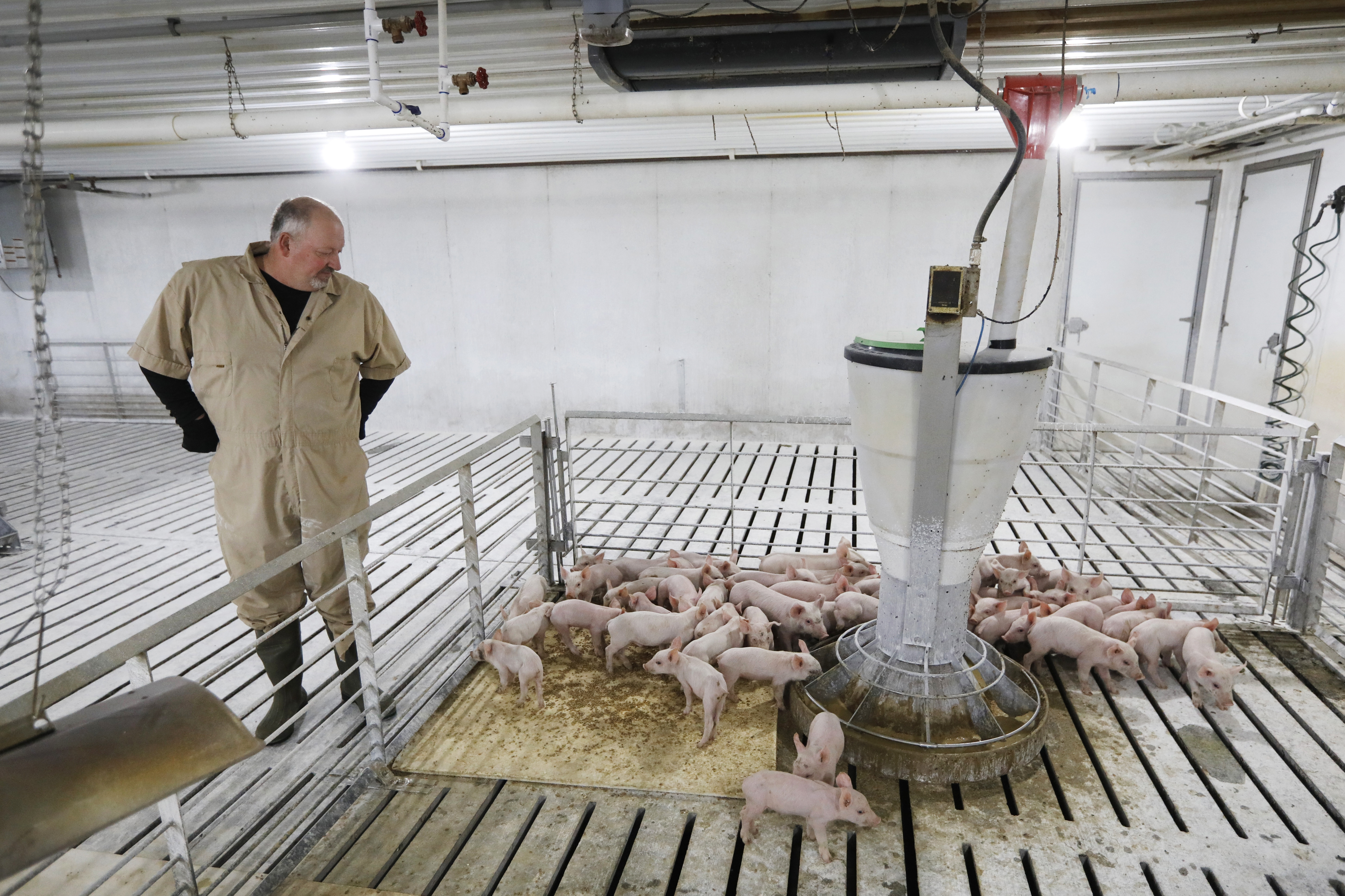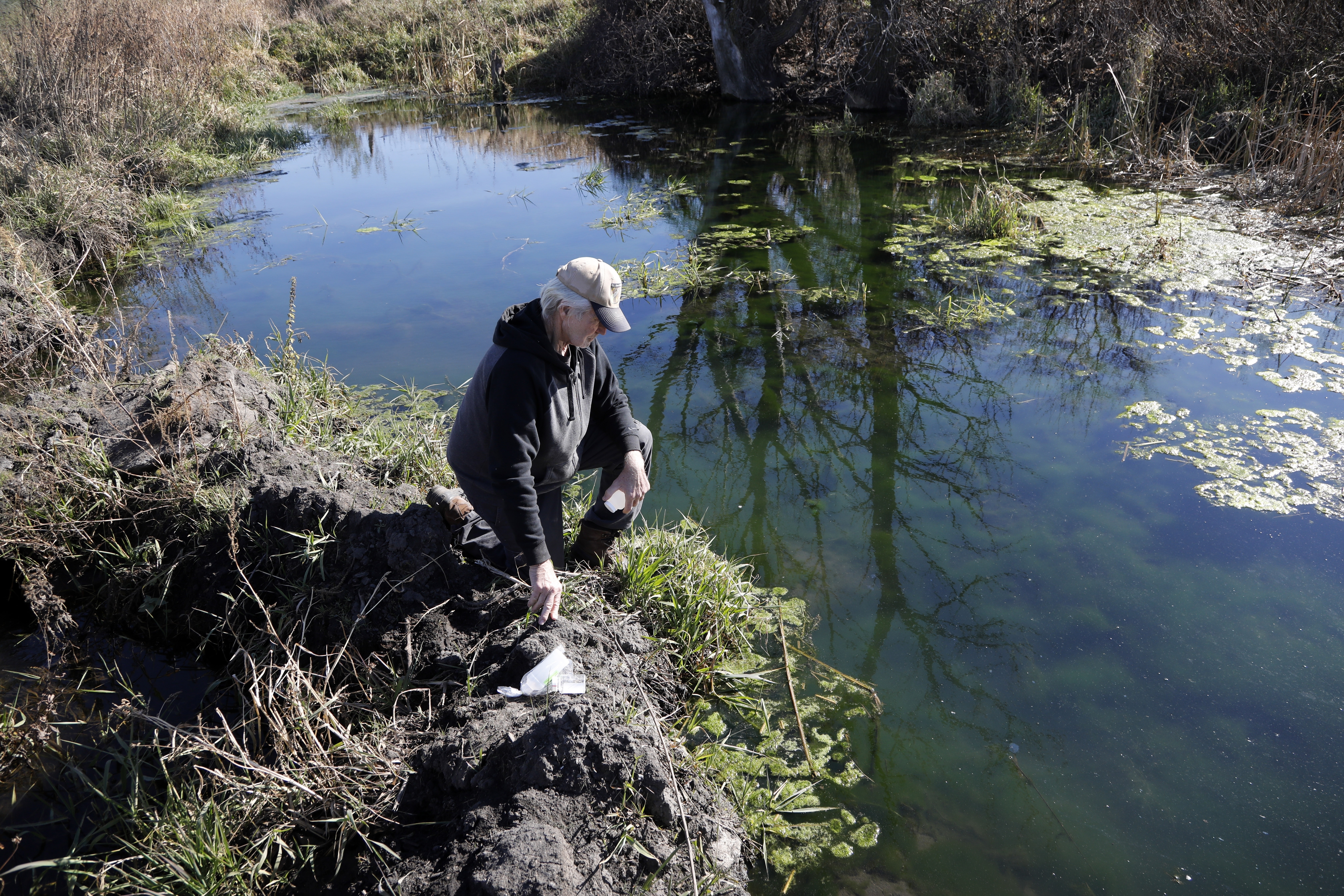
AKRON, Iowa (AP) — In recent years, Fred Zenk built two barns housing about 2,400 hogs between them — long, white, concrete-and-metal structures that are ubiquitous in the Midwestern countryside.
The Iowa farmer didn’t follow state requirements to get construction approval and file a manure disposal plan. He also put one barn too close to a creek.
But officials didn’t know that. Zenk’s operation initially flew under the radar of regulators, as have many others in Iowa and across the United States because of loopholes and spotty enforcement of laws intended to keep the nation’s air and water clean.
Beef, poultry and pork have become more affordable staples in the American diet thanks to industry consolidation and the rise of farms that can hold tens of thousands of animals. Yet federal and state environmental agencies often lack basic information about such operations, including where they’re located, how many animals they’re raising and how they deal with massive volumes of manure.
The animals and their waste have fouled waters. The enclosures spew air pollutants that promote climate change and are implicated in illnesses such as asthma. The stench of animal manure — stored in pits beneath barns or open-air lagoons and eventually spread on croplands as fertilizer — can make life miserable for people nearby.
For most of the nation’s history, meat and dairy products came from independent farms that raised animals in barnyards, pastures and rangeland. But the system now is controlled by giant companies that contract with farmers to produce livestock with the efficiency of auto assembly lines inside warehouse-like barns and sprawling feedlots.
The spread of corporate animal farms is turning neighbor against neighbor in town halls and courtrooms across rural America. Iowa, the top U.S. producer of swine and egg-laying chickens, has become a major battleground.
“It’s a fight for survival,” said Chris Petersen, one of the dwindling holdouts who still raise pigs in outdoor pens. He describes the industrial-scale newcomers, including three within a mile of his Iowa farm, as invaders that despoil the landscape and force smaller competitors to get bigger or leave the business.
Michele Merkel, a former EPA attorney who quit over the agency’s reluctance to punish polluting mega-farms and is co-director of the advocacy group Food & Water Justice, said the industry “has avoided any effective regulation and accountability for a long time.”
Industry groups scoff at the suggestion they’re under-regulated and say livestock agriculture is simply adapting to improved technology, equipment and methods. It provides consumers with a reliable and affordable food supply, creates jobs and supports local economies, they say.
“We’re responding to what the market is giving us,” said Brady Reicks, whose company runs numerous large hog structures in northeastern Iowa. “We’re doing it responsibly; we’re passionate about doing it. It increases growth in rural Iowa and it helps feed the world.”
HOW MANY ARE THERE?
The U.S. Environmental Protection Agency began to count the nation’s factory farms during the Obama administration but was forced to retreat when industry groups sued, claiming invasion of privacy and vulnerability to ecoterrorism. Instead, the agency used state data to produce annual statistics about only the biggest operations.
As of 2018, the agency’s nationwide tally was about 20,300 — a roughly five-fold increase over nearly four decades.
Yet it’s a tiny fraction of all confined animal operations. The U.S. Department of Agriculture estimates there are more than 450,000. Most are considered too small for inclusion in the EPA count, despite housing hundreds or thousands of animals.
Iowa is home to 80 million farm animals and 3 million people. Yet in 2017, regulators did not know exactly how many livestock farms were in the state. Under federal pressure to find out, the Department of Natural Resources pored over aerial photos of the countryside, discovering 4,200 previously unknown facilities teeming with animals.
Fred Zenk’s Plymouth County farm was among them.
“We knew nothing about his operation,” said Sheila Kenny, an environmental specialist with the state agency. “We didn’t know about his first building, let alone his second.”
Zenk acknowledged breaking the rules, but said no harm was done. He paid a $4,500 fine and built a berm to protect the waterway.
“You think you can get by with something once in a while and you can’t,” he said, strolling among his barns, tractor and feed bins.
To state regulators, such discoveries mean the system works.
Others say the Iowa experience shows how easily livestock operations can escape detection.
“That’s a really big gap in knowledge that keeps us from effectively regulating all these farms: We don’t even know where they are,” said Robert Martin of Johns Hopkins University’s Center for a Livable Future.

In this Nov. 1, 2018, photo, Gordon Garrison takes a water sample from a stream on his farm, in Estherville, Iowa. Garrison sued a nearby operation with 4,400 hogs, contending manure from its croplands fouls a creek that runs through his property and feeds the Des Moines River. “They’re using me for a waste disposal site,” Garrison said. (AP Photo/Charlie Neibergall)
MANURE PITS & LAGOONS
Putting thousands of animals in one enclosure produces huge amounts of manure. Unlike human sewage, which is treated and released to waterways, animal waste is stored, then spread on croplands as fertilizer. Some farmers keep it in big pits beneath the buildings, others in open-air lagoons.
Farmers insist they are careful.
“We take soil tests, we decide how much manure it needs and that’s how much we apply,” said Reicks, whose family has raised swine for six generations. “It’s in our own best interest.”
But environmental groups say fields often can’t handle the volumes of manure produced, leading to runoff during rainstorms and when snow melts. Such pollution is exempt from regulation under the 1972 Clean Water Act.
That’s even though agriculture is the biggest contaminator of rivers and streams, according to the EPA.
The 1972 law did include the biggest livestock operations among the industries that need permits for discharging waste directly into waterways — for example, when lagoons overflow. But farm groups have argued successfully in court that they should be exempt from automatic permitting because their waste spills are unintentional, rather than routine like sewage treatment and manufacturing plants that discharge wastewater through pipes.
That means the EPA or states can’t mandate permits for livestock operations unless they illegally release manure to waterways.
The result is a “catch-me-if-you-can system” that relies on vigilant citizens to report spills, said Tarah Heinzen, an attorney with Food & Water Watch.
Even when caught polluting, farms can escape permitting.
In 2014, a tipster reported dead fish in a northwestern Iowa stream. An inspector found manure from a dairy had contaminated 28 miles of water, killing more than 865,000 fish. The dairy was fined $70,000. But instead of ordering a permit, the state natural resources department — which enforces the Clean Water Act on behalf of the EPA — allowed the farm to make improvements designed to prevent future leaks.
In Emmett County, Iowa, small farmer Gordon Garrison sued a nearby operation with 4,400 hogs, contending manure from its croplands fouls a creek that runs through his property and feeds the Des Moines River.
“They’re using me for a waste disposal site,” Garrison said. “They over-apply the manure and it’s polluting our lakes and rivers. It’s a self-regulated, voluntary system and it doesn’t work.”
AIR POLLUTION AND BARNYARD SMELLS
Livestock is also a major air polluter because of the gases created by decaying manure and animals’ digestive systems. Farm animals generate about 70% of the nation’s ammonia emissions. Studies also describe animal operations as sources of gases that cause global warming, particularly methane.
Unlike other industrial facilities, however, factory farms aren’t required to get emission permits under the Clean Air Act. That’s because the government hasn’t decided how to measure emissions from barns, feedlots, storage lagoons and croplands where manure is spread.
And under President Donald Trump, EPA has exempted livestock operations from requirements under other laws that industries report significant releases of hazardous materials, including ammonia and hydrogen sulfide.
Yet odors likely inspire the most complaints about livestock farms.
Critics say yesteryear’s barnyard whiffs were nothing like the overpowering stench from today’s supersized operations.
“You don’t want to be anywhere near them,” said Brad Trom, a fourth-generation crop farmer in Minnesota’s Dodge County, who lives within three miles of 11 structures housing 30,000 swine. He says he’s been staggered by powerful odors barreling across his fields.
Farmers say they’re trying to reduce the smells. An industry group called the Coalition to Support Iowa’s Farmers has advised thousands of operations about steps such as planting tree buffers and placing odor-fighting additives in manure pits.
But factory farmers also contend smells are a normal part of country life.
“I’ve never lived on a farm that didn’t have nature’s fragrances on it,” said Gary Sovereign, a fifth-generation swine producer in Iowa’s Howard County.

In this Oct. 29, 2018, photo, Gail Schwartzkopf, of Rudd, Iowa, talks about the concentrated animal feeding operation, or CAFO, built near her home in Rudd, Iowa. Jeff and Gail Schwartzkopf say their lives changed drastically after a hog operation was built a quarter-mile from their home in northern Iowa. (AP Photo/Charlie Neibergall)
ITCHY EYES, WORTHLESS HOMES
Over the past 20 years, a growing body of research has linked proximity to factory farms to various health risks. In November, the American Public Health Association called for a halt to new or expanded megafarms until more is known about how they affect the people living nearby.
A 2013 study in Iowa found a link between exposure to large swine structures and childhood asthma and wheezing. Another found patients at an Iowa veterans’ hospital were nearly three times as likely to carry a hard-to-treat germ if they lived within a mile (1.6 kilometers) of a big hog farm.
But neither established a clear cause-and-effect relationship or determined whether the links harmed health.
Health researchers acknowledge it’s nearly impossible to pin someone’s illness on a certain polluter, frustrating rural residents who say they were fine until getting a livestock confinement for a neighbor.
“You almost never have a study that covers the entire pathway from the source of the exposure to a person’s health condition,” said Jillian Fry, a public health scientist with Johns Hopkins University.
Jeff and Gail Schwartzkopf say their lives changed drastically after a hog operation was built a quarter-mile from their home in northern Iowa. They say they developed burning and itching eyes, throat soreness and body rashes. They believe the barn is making them sick, but can’t prove it.
The board fence they built at the edge of their yard hasn’t helped, nor have the evergreens they planted. Jeff Schwartzkopf, a truck painter, said his family’s home is ruined — and more swine facilities are moving into the neighborhood. About 30,000 hogs are within 2.5 miles (4 kilometers) of their house.
“Nobody’s going to want to buy it. We’re stuck,” he said.
Legislatures have started clamping down on residents’ ability to sue in such situations. Iowa, for example, capped damages and made it harder to prove livestock operations harm human health or property values. And like other states where agriculture is king, it also forbids local regulation of livestock farms.
BATTLEGROUND IOWA
Critics say the industry that defines Iowa has lost its way, with government watchdogs asleep on the job.
Some opponents are trying something new: Farms producing more manure than their croplands can handle often send it to others. In Howard County, more than 40 families have pledged not to accept it or rent land for factory farming.
“We’re not radicals,” said Sue George, a retired teacher who helped organize the initiative. “We’re just concerned citizens. We do not feel that confinements have the right to just come in and set up shop with no permission and ruin what we have here.”
Sovereign, the Iowa farmer, says the factory system is clean, efficient and meets consumer demand for inexpensive, tasty pork.
He typically showers and dons sanitary coveralls before entering a nursery building where more than 2,000 young pigs fatten for slaughter inside, to avoid exposing the animals to infections.
Computers monitor the barn’s temperature. Chips in each hog’s ear track food consumption. The pinkish pigs squeal and grunt as they roam the manure-spattered wooden floor.
Below lies an 850,000-gallon waste pit, bigger than an Olympic-sized swimming pool.
“This,” says Sovereign, with a sweeping gesture toward the scene, “is where your food comes from.”
___
Follow Flesher on Twitter: @johnflesher
___
The Associated Press Health and Science Department receives support from the Howard Hughes Medical Institute’s Department of Science Education. The AP is solely responsible for all content.
Read Great Lakes Now’s coverage of the environmental impact of farming:
Muddied Waters: Bureaucratic process leaves well water at risk and farmers feeling targeted
IJNR Snapshots: Some Ohio farmland is being returned to its glory days as the Great Black Swamp
Animal Culprit: Study Points to Animal Farms as Growing Contributors to Lake Erie Algae
Featured image: In this Oct. 31, 2018, photo, Gary Sovereign checks on hogs feeding in a concentrated animal feeding operation, or CAFO, on his farm in Lawler, Iowa. Sovereign says the factory system is clean, efficient and meets consumer demand for inexpensive, tasty pork. He typically showers and dons sanitary coveralls before entering a nursery building where more than 2,000 young pigs fatten for slaughter inside, to avoid exposing the animals to infections. (AP Photo/Charlie Neibergall)




